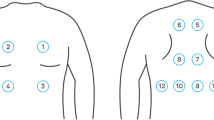Abstract
Chest auscultation is a crucial and efficient method for diagnosing lung disease; however, it is a subjective process that relies on physician experience and the ability to differentiate between various sound patterns. Because the physiological signals composed of heart sounds and pulmonary sounds (PSs) are greater than 120 Hz and the human ear is not sensitive to low frequencies, successfully making diagnostic classifications is difficult. To solve this problem, we constructed various PS recognition systems for classifying six PS classes: vesicular breath sounds, bronchial breath sounds, tracheal breath sounds, crackles, wheezes, and stridor sounds. First, we used a piezoelectric microphone and data acquisition card to acquire PS signals and perform signal preprocessing. A wavelet transform was used for feature extraction, and the PS signals were decomposed into frequency subbands. Using a statistical method, we extracted 17 features that were used as the input vectors of a neural network. We proposed a 2-stage classifier combined with a back-propagation (BP) neural network and learning vector quantization (LVQ) neural network, which improves classification accuracy by using a haploid neural network. The receiver operating characteristic (ROC) curve verifies the high performance level of the neural network. To expand traditional auscultation methods, we constructed various PS diagnostic systems that can correctly classify the six common PSs. The proposed device overcomes the lack of human sensitivity to low-frequency sounds and various PS waves, characteristic values, and a spectral analysis charts are provided to elucidate the design of the human-machine interface.









Similar content being viewed by others

References
Earis, J. E., and Cheetham, B. M. G., Current methods used for computerized respiratory sound analysis. Eur. Respir. Rev. 10:586–590, 2000.
Polat, H., and Guler, I., A simple computer-based measurement and analysis system of pulmonary auscultation sounds. J Med. Syst. 28:665–667, 2004.
Guler, E., Sankur, B., Kahya, Y., and Raudys, S., Two-stage classification of respiratory sound patterns. J. Comput. Biol. Med. 35:67–83, 2005.
Pittner, S., and Kamarthi, S. V., Feature extraction from wavelet coefficients for pattern recognition tasks. IEEE Trans. Pattern Anal. Mach. Intell. 21:83–88, 1999.
Hadjileontiadis, L. J., and Panas, S. M., Autoregressive modeling of lung sounds using higher-order statistics: Estimation of source and transmission. IEEE Signal Processing Workshop on Higher-Order Statistics, pp. 4–8, 1997.
Hadjileontiadis, L. J., Wavelet-based enhancement of lung and bowel sounds using fractal dimension thresholding-Part I: Methodology. IEEE Trans. Biomed. Eng. 52:1143–1148, 2005.
Hadjileontiadis, L. J., Wavelet-based enhancement of lung and bowel sounds using fractal dimension thresholding-Part II: Application results. IEEE Trans. Biomed. Eng. 52:1050–1064, 2005.
Homs-Corbera, A., Fiz, J. A., Morera, J., and Jane, R., Time-frequency detection and analysis of wheezes during forced exhalation. IEEE Trans. Biomed. Eng. 51:182–186, 2004.
Bahoura, M., and Pelletier, C., Respiratory sounds classification using cepstral analysis and Gaussian mixture models. IEEE Trans. Electr. Comput. Eng. 3:1309–1312, 2004.
Kahya, Y. P., Yeginer, M., and Bilgic, B. Classifying respiratory sounds with different feature sets. IEEE Conferences on 28th Engineering in Medicine and Biology Society, 2856–2859, 2006.
Sezgin, M. C., Dokur, Z., Olmez, T., and Korurek, M., Classification of respiratory sounds by using an artificial neural network. 23rd Annual International Conference on Engineering in Medicine and Biology Society :697–699, 2001.
Dokur, Z., Respiratory sound classification by using an incremental supervised neural network. Springer-Verlag London Limited, 309–319, 2008.
Guler, I., Polat, H., and Ergun, U., Combining neural network and genetic algorithm for prediction of lung sounds. J. Med. Syst. 29:217–231, 2005.
Waitman, R. L., Clarkson, P. K., Barwise, A. J., and King, H. P., Representation and classification of breath sounds recorded in an intensive care set. J. Clin. Monit. Comput. 16:95–105, 2000.
Feng, J., Krishnan, S., and Sattar, F., Adventitious sounds identification and extraction using temporal-spectral dominance-based features. IEEE Trans. Biomed. Eng. 58:3078–3087, 2011.
Er, O., Temurtas, F., and Tanrıkulu, A., Tuberculosis disease diagnosis using artificial neural networks. J. Med. Syst. 34:299–302, 2010.
Sovijarvi, A. R. A., and Malmberg, L. P., Characteristics of breath sounds and adventitious respiratory sounds. Eur. Respir. Rev. 10:591–596, 2000.
Taplidou, S. A., and Hadjileontiadis, L. J., Analysis of wheezes using wavelet higher order spectral features. IEEE Trans. Biomed. Eng. 57:1596–1610, 2010.
Wang, W., and Jianu, O. A., A smart sensing unit for vibration measurement and monitoring. IEEE/ASME Trans. Mechatron. 15:70–78, 2010.
Lin, Y. D., Tsai, C. D., Huang, H. H., Chiou, D. C., and Wu, C. P., Preamplifier with a second-order high-pass filtering characteristic. IEEE Trans. Biomed. Eng. 46:609–612, 1999.
Hwee, C. L., and Shirinzadeh, B., Neural network motion tracking control of piezo-actuated flexure-based mechanisms for micro-/nanomanipulation. IEEE/ASME Trans. Mechatron. 14:517–527, 2009.
Stethographics, http://www.stethographics.com. Accessed: 2010-Feb.
Steven, L., Understanding lung sounds, 3rd edition. Saunders, Philadelphia, 2002.
Horng, M. H., Performance evaluation of multiple classification of the ultrasonic supraspinatus images by using ML, RBFNN and SVM classifiers. J. Expert Syst. Appl. 37:4146–4155, 2010.
Sezer, E., Isik, H., and Saracoglu, E., Employment and comparison of different artificial neural networks for epilepsy diagnosis from EEG signals. J. Med. Syst. 36:347–362, 2012.
Kocer, S., and Canal, M. R., Classifying epilepsy diseases using artificial neural networks and genetic algorithm. J. Med. Syst. 35:489–498, 2011.
Conflict of interest
The authors declare that they have no conflicts of interest.
Author information
Authors and Affiliations
Corresponding author
Additional information
This article is part of the Topical Collection on Education & Training
Rights and permissions
About this article
Cite this article
Chen, MY., Chou, CH. Applying Cybernetic Technology to Diagnose Human Pulmonary Sounds. J Med Syst 38, 58 (2014). https://doi.org/10.1007/s10916-014-0058-5
Received:
Accepted:
Published:
DOI: https://doi.org/10.1007/s10916-014-0058-5



